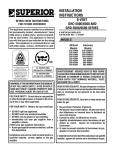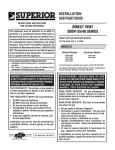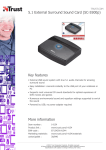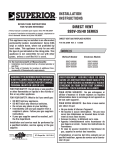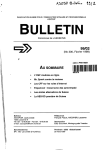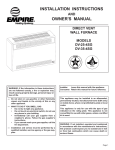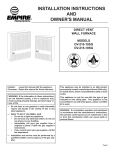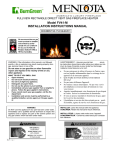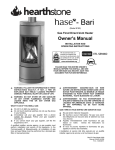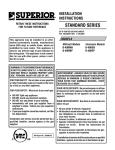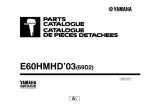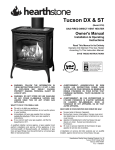Download TOA Electronics P0055-DRG User's Manual
Transcript
HOMEOWNER'S CARE AND OPERATION INSTRUCTIONS B-VENT GHC/GRD-5500 SERIES B-VENTED GAS FIREPLACES P/N 725,029M REV. C 07/2004 MODELS GRD-5500 SHOWN Millivolt Models Electronic Models GHC-5500N GHC-5500P GRD-5500N GRD-5500P GHC-5500NE-2 GHC-5500PE-2 GRD-5500NE-2 GRD-5500PE-2 RETAIN THESE INSTRUCTIONS FOR FUTURE REFERENCE WH Report No. J20046562 WARNING: IF THE INFORMATION IN THIS MANUAL IS NOT FOLLOWED EXACTLY, A FIRE OR EXPLOSION MAY RESULT CAUSING PROPERTY DAMAGE, PERSONAL INJURY OR LOSS OF LIFE. FOR YOUR SAFETY: Do not store or use gasoline or other flammable vapors or liquids in the vicinity of this or any other appliance. FOR YOUR SAFETY: What to do if you smell gas: AVERTISSEMENT: ASSUREZ-VOUS DE BIEN SUIVRE LES INSTRUCTIONS DONNÉ DANS CETTE NOTICE POUR RÉDUIRE AU MINIMUM LE RISQUE D'INCENDIE OU POUR ÉVITER TOUT DOMMAGE MATÉRIEL, TOUTE BLESSURE OU LA MORT. POUR VOTRE SÉCURITÉ: Ne pas entreposer ni utiliser d'essence ni d'autre vaperurs ou liquides inflammables dans le voisinage de cet appareil ou de tout autre appareil. POUR VOTRE SÉCURITÉ: Que faire si vous sentez une odeur de gaz: DO NOT light any appliance. DO NOT touch any electrical switches. DO NOT use any phone in your building. Immediately call your gas supplier from a neighbor’s phone. Follow your gas suppliers instructions. • If your gas supplier cannot be reached, call the fire department. • Ne pas tenter d'allumer d'appareil. • Ne touchez à aucun interrupteur. Ne pas vous servir des téléphones se trouvant dans le batiment où vous vous trouvez. • Evacuez la piéce, le bâtiment ou la zone. • Appeflez immédiatement votre fournisseur de gaz depuis un voisin. Suivez les instructions du fournisseur. • Si vous ne pouvez rejoindre le fournisseur de gaz, appelez le service dos incendies. Installation and service must be performed by a qualified installer, service agency or the gas supplier. L'installation et service doit être exécuté par un qualifié installer, agence de service ou le fournisseur de gaz. • • • • NOTE: DIAGRAMS & ILLUSTRATIONS NOT TO SCALE. 1 CONGRATULATIONS! In selecting this Superior B-vented gas appliance you have chosen the finest and most dependable fireplace to be found anywhere. A beautiful, prestigious, alternative to a wood burning fireplace. Welcome to a Family of tens of thousands of satisfied Superior Fireplace Owners. Please read and carefully follow all of the instructions found in this manual. Please pay special attention to the safety instructions provided in this manual. The Homeowner's Care and Operation Instructions included here will assure that you have many years of dependable and enjoyable service from your Superior product. TABLE OF CONTENTS Introduction ..................................... page General Information ......................... page 2 2 Operation/Care of Your Appliance .... page Gas Controls/Control 3 Compartment Access ...................... page Combustion Air Controls ................. page 3 4 Maintenance .................................... page Manual Limit Switch ........................ page 5 5 Burner Adjustments ......................... page Flame Appearance and Sooting ..... page 5 5 Adjustment ................................... page Maintenance Schedule ..................... page 5 6 Log and Rockwool Placement ......... page Millivolt Appliance Checkout ............ page 7 7 Electronic Appliance Checkout ......... page Wiring Diagrams .............................. page 7 9 Warranty .......................................... page Product Reference Information ....... page 9 9 Replacement Parts .......................... page 9 Lighting Instructions – Millivolt ....... page 10 Lighting Instructions – Electronic .... page 12 Troubleshooting Guide – Millivolt ..... page 14 Troubleshooting Guide – Electronic .. page 15 Accessory Components ................... page 16 Replacement Parts List ..................... page 17 INTRODUCTION The millivolt appliances are designed to operate on either natural or propane gas. A millivolt gas control valve with piezo ignition system provides safe, efficient operation. The electronic appliances are designed to operate on either natural or propane gas. An electronic intermittent pilot system provides safe, efficient operation. External electrical power is required to operate these units. 2 These appliances comply with National Safety Standards and are tested and listed by Warnock Hersey (Report No. J20046562) to ANSI ANSI Z21.50 - 2000 (in Canada, CSA 2.22 - 2000), and CAN/CGA-2.17-M91 in both USA and Canada, as vented gas fireplaces. Installation must conform to local codes. In the absence of local codes, installation must comply with the current National Fuel Gas Code, ANSI Z223.1 (NFPA 54). (In Canada, the current CAN/CGA B149 installation code.) Electrical wiring must comply with local codes. In the absence of local codes, installation must be in accordance with the National Electrical Code, NFPA 70 - (latest edition). (In Canada, the current CSA C22.1 Canadian Electric Code.) DO NOT ATTEMPT TO ALTER OR MODIFY THE CONSTRUCTION OF THE APPLIANCE OR ITS COMPONENTS. ANY MODIFICATION OR ALTERATION MAY VOID THE WARRANTY, CERTIFICATION AND LISTINGS OF THIS UNIT. Provide adequate clearances around air openings and adequate accessibility clearance for service and proper operation. Never obstruct the front openings of the appliance. Due to high temperatures the appliance should be located out of traffic and away from furniture and draperies. Locate furniture and window coverings accordingly. WARNING: THESE FIREPLACES ARE VENTED DECORATIVE GAS APPLIANCES. DO NOT BURN WOOD OR OTHER MATERIAL IN THESE APPLIANCES. These appliances are designed to operate on natural or propane gas only. The use of other fuels or combination of fuels will degrade the performance of this system and may be dangerous. For elevations of 0-2000 ft. (0-610 m.) the GHC/GRD-5500 input is 24,000 BTU/HR for both natural and propane gases. Table 1 shows the units' factory-installed gas orifice size for installations at elevations of 0-2000 feet (0-610 meters). GHC GRD Series 5500 WARNING: IMPROPER INSTALLATION, ADJUSTMENT, ALTERATION, SERVICE OR MAINTENANCE CAN CAUSE INJURY OR PROPERTY DAMAGE. REFER TO THIS MANUAL. FOR ASSISTANCE OR ADDITIONAL INFORMATION CONSULT A QUALIFIED INSTALLER, SERVICE AGENCY OR THE GAS SUPPLIER. GENERAL INFORMATION Note: Installation and repair should be performed by a qualified service person. The appliance should be inspected annually by a qualified professional service technician. More frequent inspections and cleanings may be required due to excessive lint from carpeting, bedding material, etc. It is imperative that the control compartment, burners and circulating air passage ways of the appliance be kept clean. S'assurer que le brùleur et le compartiment des commandes sont propres. Voir les instructions d'installation et d'utilisation qui accompagnent l'apareil. NOTE: DIAGRAMS & ILLUSTRATIONS NOT TO SCALE. Orifice size Nat. Prop. #43 #54 Elevation Feet (meters) 0-2000 (0-610) Table 1 Nominal operating pressures for the manifold side of the gas control system are; 3.5 inches water column (6.54 MmHg) for natural gas models and 10 inches water column (18.69 MmHg) for propane gas models. Do not use these appliances if any part has been under water. Immediately call a qualified, professional service technician to inspect the appliance and to replace any parts of the control system and any gas control which have been under water. Ne pas se servir de cet appareil s'il a été plongé dans l'eau, complètement ou en partie. Appeler un technicien qualifié pour inspecter l'appareil et remplacer toute partie du système de contrôle et toute commande qui ont été plongés dans l'lau. Millivolt appliances may be fitted at time of manufacture with either a Robertshaw millivolt gas control valve or Robertshaw electronic gas control valve. Both valves have been tested with and approved for use with these appliances and are listed accordingly. A ¹⁄₈" NPT test gage connection is provided on either gas control valve adjacent to the outlet to the main burner. Minimum inlet gas pressure to the appliance is 4.5 inches water column (8.55 MmHg) for natural gas and 11 inches water column (20.55 MmHg) for propane for the purpose of input adjustment. Maximum inlet gas supply pressure to the appliance is 10.5 inches water column (19.95 MmHg) for natural gas and 13.0 inches water column (24.25 MmHg) for propane. The appliance must be isolated from the gas supply piping system (by closing its individual manual shut-off valve) during any pressure testing of the gas supply piping system at test pressures equal to or less than ¹⁄₂ psig (3.5 kPa). The appliance and its individual shut-off valve must be disconnected from the gas supply piping system during any pressure testing of that system at pressures in excess of ¹⁄₂ psig (3.5 kPa). These appliances must not be connected to a chimney or flue serving a separate solid fuel burning appliance. WARNING: FAILURE TO COMPLY WITH THE INSTALLATION AND OPERATING INSTRUCTIONS PROVIDED IN THIS DOCUMENT WILL RESULT IN AN IMPROPERLY INSTALLED AND OPERATING APPLIANCE, VOIDING ITS WARRANTY. ANY CHANGE TO THIS APPLIANCE AND/OR ITS OPERATING CONTROLS IS DANGEROUS. IMPROPER INSTALLATION OR USE OF THIS APPLIANCE CAN CAUSE SERIOUS INJURY OR DEATH FORM FIRE, BURNS, EXPLOSION OR CARBON MONOXIDE POISONING. Carbon Monoxide Poisoning: Early signs of carbon monoxide poisoning are similar to the flu with headaches, dizziness and/or nausea. If you have these signs, obtain fresh air immediately. Turn off the gas supply to the appliance and have it serviced by a qualified professional, as it may not be operating correctly. WARNING: B-VENT APPLIANCES ARE NOT DESIGNED TO OPERATE IN NEGATIVELY PRESSURED ENVIRONMENTS (PRESSURE WITHIN THE HOME IS LESS THAN PRESSURES OUTSIDE). SIGNIFICANT NEGATIVELY PRESSURED ENVIRONMENTS CAUSED BY WEATHER, HOME DESIGN, OR OTHER DEVICES MAY IMPACT THE OPERATION OF THESE APPLIANCES. NEGATIVE PRESSURES MAY RESULT IN POOR FLAME APPEARANCE, SOOTING, DAMAGE TO PROPERTY AND/OR SEVERE PERSONAL INJURY. DO NOT OPERATE THESE APPLIANCES IN NEGATIVELY PRESSURED ENVIRONMENTS. WARNING: CHILDREN AND ADULTS SHOULD BE ALERTED TO THE HAZARDS OF HIGH SURFACE TEMPERATURES. USE CAUTION AROUND THE APPLIANCE TO AVOID BURNS OR CLOTHING IGNITION. YOUNG CHILDREN SHOULD BE CAREFULLY SUPERVISED WHEN THEY ARE IN THE SAME ROOM AS THE APPLIANCE. WARNING: DO NOT PLACE CLOTHING OR OTHER FLAMMABLE MATERIALS ON OR NEAR THIS APPLIANCE. AVERTISSEMENT: SURVEILLER LES ENFANTS. GARDER LES VÊTEMENTS, LES MEUBLES, L'ESSENCE OU AUTRES LIQUIDES À VAPEUR INFLAMMABLES LIN DE L'APPAREIL. Piezo Ignitor Millivolt Gas Valve Figure 1 Control Compartment Access - GRD-5500 Units The lower control compartment access panel has been designed to cover the control compartment from view. Lighting instructions are displayed on the back side of the cover for easy reference. To attach the panel to the appliance, hook both ends of the panel over the two brackets mounted on each side of the front combustion opening. The cover should hang from the brackets with the flared edge at the bottom allowing for a small air gap between the cover and the appliance. To remove, lift the panel and pull away from the unit. Control Compartment Access - GHC-5500 Units The GHC lower control compartment access is provided by removing the three louvers . To remove the louvers, pull them straight out from the unit. To replace, tilt each of them with the top edge over the top of each peg and snap the lower edge to lock in place. See Figure 2. OPERATION AND CARE OF YOUR APPLIANCE Appliance operation must be controlled through a remotely located wall switch (factory-supplied). Separate switches may provide independent control for the remote controlled fireplace operation (optional equipment). Gas Controls/Control Compartment Access See Figure 1 for the location of the gas control valve and piezo ignitor (millivolt units). NOTE: DIAGRAMS & ILLUSTRATIONS NOT TO SCALE. Louver Pegs Louvers Figure 2 GHC-5500 3 O N O F F ON/OFF SWITCH CONTROL KNOB AVERTISSEMENT: POUR UTILISATION UNIQUEMENT AVEC LES PORTES EN VERRE CERTIFIÊES AVEC L'APPAREIL. P C M MILLIVOLT GAS CONTROL VALVE Figure 3 Operation of millivolt and electronic gas control systems are different. Before lighting and operating your appliance determine if you have a millivolt or electronic appliance. Millivolt appliances will be fitted with the gas control valve shown in Figure 3. Appliances with electronic systems will be fitted with the electronic valve shown in Figure 4. Familiarize yourself with the differing controls for the valve your appliance uses. Millivolt Appliance Lighting To light millivolt appliances refer to the detailed lighting instructions found in both English and French on pages 10 and 11 of these instructions respectively. Appliance lighting instructions may also be found on the pullout label located near the gas valve in the control compartment. Refer to Figure 1 for the piezo ignitor location used with your appliance. ELECTRONIC GAS CONTROL VALVE Figure 4 2. Keep lower control compartment clean by vacuuming or brushing at least twice a year. More frequent cleaning may be required due to excessive lint from carpeting, bedding materials, etc. It is important that control compartments, burners and circulating air passageways of the appliance be kept clean. 3. Always turn off gas to the pilot (millivolt appliances) before cleaning. Before re-lighting, refer to the lighting instructions in this manual. Appliance lighting instructions may also be found on the pull-out label located near the gas valve in the control compartment. 4. Always keep the appliance area clear and free from combustible materials, gasoline and other flammable liquids. 5. Remember, Millivolt appliances have a continuous burning pilot flame. Exercise caution when using products with combustible vapors. Your appliance comes supplied with remote wall switch or can be used with an optional remote control kit. The appliance main burner may be turned on and off with the wall switch or remote control. 6. Clean the optional glass doors only when necessary. Wipe surface with clean, dampened, soft cloth. Follow with dry, soft towel as desired. Take care not to scratch the glass surface. Electronic Appliance Lighting To light electronic appliances refer to the detailed lighting instructions found in both English and French on pages 12 and 13 of these instructions respectively. Appliance lighting instructions may also be found on the pullout label located near the gas valve in the control compartment. WARNING: DO NOT USE ABRASIVE CLEANERS. NEVER CLEAN THE GLASS WHEN IT IS HOT. Your appliance comes supplied with remote wall switch or can be used with an optional remote control kit. The appliance main burner may be turned on and off with the wall switch or remote control. 1. When lit for the first time, this appliance will emit a slight odor for an hour or two. This is due to the “burn-in” of internal paints and lubricants used in the manufacturing process. Glass Doors Fully Open or Fully Closed (Bi-Fold Doors) Figure 5 Outside Combustion Air Controls Appliances may be installed with an outside (make-up air) vent system that is designed to provide the appliance with outside make-up air for combustion when in operation. The shut-off lever for the outside air system is standard on all appliances but should not be operated if the complete system is not installed. Refer to Figure 6 for GHC/GRD-5500 series units. The hand operated shut-off lever is located in the left side of the fireplace opening behind the screen. To open, pull all the way. The outside air damper should be fully open when the fireplace is in use and completely closed when the fireplace is not being used. This will prevent outside cold air from entering the dwelling. WARNING: DO NOT OPERATE THE SHUTOFF LEVER UNLESS A COMPLETE OUTSIDE AIR VENT SYSTEM HAS BEEN INSTALLED WITH YOUR APPLIANCE. CAUTION: DO NOT ATTEMPT TO TOUCH THE DOORS WITH YOUR HANDS WHILE THE FIREPLACE IS IN USE. ALWAYS USE DOOR HANDLES. DOORS WILL BECOME VERY HOT WHEN FIREPLACE IS IN USE. WARNING: FIREPLACES EQUIPPED WITH OPTIONAL ACCESSORY DOORS SHOULD BE OPERATED ONLY WITH THE DOORS FULLY OPEN OR FULLY CLOSED (FIGURE 5 ). THIS APPLIANCE MAY ONLY BE FITTED WITH DOORS CERTIFIED FOR USE WITH THE APPLIANCE. Combustion Air Control Lever Combustion Air Control Lever on GHC/GRD-5500 Series Units Figure 6 4 NOTE: DIAGRAMS & ILLUSTRATIONS NOT TO SCALE. Maintenance Manual Reset Limit Switch The appliance and venting system should be thoroughly inspected before initial use and at least annually by a qualified service technician. Proper maintenance and use will require more frequent, less extensive inspections and servicing by the homeowner. Generally, annual inspections should be performed by a qualified service technician. More frequent periodic inspections and cleanings should be performed by the homeowner. Any discrepancies discovered by the homeowner should result in a call to a qualified service technician to effect the repair or correction. Lintel Extention Refer to the maintenance schedule for maintenance tasks, procedures, periodicity and by whom they should be performed. IMPORTANT: TURN OFF GAS AND ANY ELECTRICAL POWER BEFORE SERVICING THE APPLIANCE. MANUALLY-RESET BLOCKED FLUE SAFETY SWITCH This appliance is equipped with a manuallyreset blocked flue safety switch. Refer to Figure 7 for its location. If during appliance operation, the flame goes out (independently of the burner on/off wall switch), it may be due to the operation of this safety limit switch. First allow the appliance to cool. Then reset the safety switch by pushing the red reset button on the back of the switch. CAUTION: THE ELECTRONIC APPLIANCE SHOULD BE TURNED OFF BEFORE REMOVING THE LIMIT SWITCH. To access the safety limit switch reset button, remove the two screws. Pull out limit switch with low voltage wires attached, push the reset button, then reinstall the limit switch. At this time turn the electronic appliance back on. The appliance should then relight and remain lit. If this does not occur, turn off the appliance and call a qualified service technician. Burner Adjustments Flame Appearance and Sooting Firebox Wrapper Limit Switch Screws Figure 7 If the air shutter opening is too small sooting may develop. Sooting is indicated by black puffs developing at the tips of very long orange flames. Sooting results in black deposits forming on the logs, appliance inside surfaces and on exterior surfaces adjacent to the vent termination. Sooting is caused by incomplete combustion in the flames and a lack of combustion air entering the air shutter opening. Adjustment To adjust the flame, position the air shutter to the nominal setting (Figure 8 ). Allow the burner to operate for at least 30 minutes. Observe the flame continuously. If it appears weak or sooty as previously described, adjust the air shutter open or closed until desired effect is achieved. To achieve a warm yellow to orange flame with an orange body that does not soot, the shutter opening must be adjusted between these two extremes. Orifice Air Shutter No smoke or soot should be present. Reposition the log set if the flames impinge on any of them. Adjusting Set Screw If sooting conditions exist, the air shutter opening on the main burner can be adjusted. Normally, the more offsets in the vent system, the greater the need for the air shutter to be opened further. WARNING: AIR SHUTTER ADJUSTMENT SHOULD ONLY BE PERFORMED BY A QUALIFIED PROFESSIONAL SERVICE TECHNICIAN. Burner Tube Nominal Air Shutter Settings: Natural Gas - Closed Propane Gas - 1/6 in. (1.59 mm) Open Figure 8 Proper flame appearance is a matter of taste. Generally most people prefer the warm glow of a yellow to orange flame. Appliances operated with air shutter openings that are too large, or with long vertical vent runs, will exhibit flames that are blue and transparent. These weak, blue and transparent flames are termed anemic. NOTE: DIAGRAMS & ILLUSTRATIONS NOT TO SCALE. 5 Maintenance Schedule Annually (Before the onset of the Burning Season) Maintenance Task Accomplishing Person Procedure Inspecting/Cleaning Burner, Logs and Controls Qualified Service Technician Inspect valve and ensure it is properly operating. Check piping for leaks. Vacuum the control compartment, fireplace logs and burner area. Check Flame Patterns and Flame Height Qualified Service Technician Refer to Figure 10 on page 7 and verify the flame pattern and height displayed by the appliance conforms to the picture. Inspecting/Cleaning Pilot and Burner Qualified Service Technician Refer to Figure 11 on page 7. Remove any surface build-up on pilot and burner assembly. Wipe the pilot nozzles, ignitor/flame rod and hood. Ensure the pilot flame engulfs the flame sensor as shown. Checking Vent System Qualified Service Technician Inspect the vent system at the top and at the base (within the firebox) for signs of blockage or obstruction. Look for any signs of dislocation of the vent components. Appliance Checkout Qualified Service Technician Perform the appropriate appliance checkout procedure detailed in this manual. Replacing Rockwool Ember Materials Homeowner/Qualified Services Technician Remove old ember materials and vacuum the rockwool placement area. Place new rockwool as described in this document. Periodically (After the Burning Season) Maintenance Task 6 Accomplishing Person Procedure Cleaning Firebox Interior Homeowner Carefully remove logs, Rockwool and volcanic stone if used. Vacuum out interior of the firebox. Clean firebox walls and log grate. Replace logs, Rockwool and volcanic stone as detailed in this manual. Check Flame Patterns and Flame Height Homeowner Refer to Figure 10 on page 7 and verify the flame pattern and height displayed by the appliance conforms to the picture. Flames must not impinge on the logs. Checking Vent System Homeowner Inspect the vent system at the top and at the base (within the firebox) for signs of blockage or obstruction. Look for any signs of dislocation of the vent components. Cleaning Optional Glass Doors Homeowner Clean as necessary following the directions provided in this manual. DO NOT TOUCH OR ATTEMPT TO CLEAN DOORS WHILE THEY ARE HOT. NOTE: DIAGRAMS & ILLUSTRATIONS NOT TO SCALE. Logs and Rockwool (Glowing Embers) Placement WARNING: LOGS GET VERY HOT AND WILL REMAIN HOT UP TO ONE HOUR AFTER GAS SUPPLY IS TURNED OFF. HANDLE ONLY WHEN LOGS ARE COOL. TURN OFF ALL ELECTRICITY TO THE APPLIANCE BEFORE YOU INSTALL GRATE AND LOGS. WARNING: THIS APPLIANCE IS NOT MEANT TO BURN WOOD. ANY ATTEMPT TO DO SO COULD CAUSE IRREPARABLE DAMAGE TO YOUR APPLIANCE AND PROVE HAZARDOUS TO YOUR SAFETY. Rockwool Figure 10 Millivolt Appliance Checkout WARNING: THE SIZE AND POSITION OF THE LOG SET WAS ENGINEERED TO GIVE YOUR APPLIANCE A SAFE, RELIABLE AND ATTRACTIVE FLAME PATTERN. ANY ATTEMPT TO USE A DIFFERENT LOG SET IN THE FIREPLACE WILL VOID THE WARRANTY AND WILL RESULT IN INCOMPLETE COMBUSTION, SOOTING, AND POOR FLAME QUALITY. The gas control system on these appliances is a millivolt standing pilot type. It consists of a pilot burner, a piezo ignitor, a gas control valve, a burner assembly and an ON/OFF wall switch. A temperature limit switch is wired in series with the millivolt wall switch and gas control valve. If a higher than normal temperature is sensed due to a blocked vent or prolonged downdraft, the limit switch will open and cause the burner to shut off. The logs are packaged within the firebox. The bag of rockwool is in the lower control compartment. Remove the rockwool from the packaging and tear into dime size pieces (Figure 9). Spread across the burner in front of the front log. See Figure 10. Do not use more than is necessary to cover the burner. When properly positioned, the rockwool will unevenly cover approximately 85% of the front of the burner with no appreciable gaps. The pilot flame should be steady, not lifting or floating. Flame should be blue in color with traces of orange at the outer edge. 1. Remove the pilot adjustment cap located on the main gas valve. 2. Adjust the pilot screw to provide properly sized pilot flame (Figure 10 ). Turn counter clockwise to enlarge pilot flame and clockwise to reduce the pilot flame. DO NOT attempt to adjust pilot flame more than one half turn. 3. Replace the pilot adjustment cap. The top ³⁄₈" (9 mm) at the pilot generator (thermopile) should be engulfed in the pilot flame (Figure 11). Replace logs if removed for pilot inspection. To light the burner; rotate the gas valve control knob counterclockwise to the “ON” positionand then turn “ON” the remote wall switch. Electronic Appliance Checkout ³⁄₈" (10 mm) These appliances are equipped with a beautifully crafted four (4) piece ceramic fiber log set. The logs, shown in Figure 12 on page 8, are to be positioned precisely as shown. Any modification to the to the lay of these logs may result in sooting, property damage and injury or death. Figure 11 Figure 9 If the pilot flame pattern is not as shown in Figure 11, adjust it as follows: WARNING: PILOT FLAME PATTERN ADJUSTMENT SHOULD ONLY BE PERFORMED BY A QUALIFIED PROFESSIONAL SERVICE TECHNICIAN. NOTE: DIAGRAMS & ILLUSTRATIONS NOT TO SCALE. The gas control system on these appliances is an electronic low voltage gas control valve with an intermittent ignitor. It consists of a low voltage gas control valve, an intermittent ignition system, an electronic control module, transformer and a burner assembly. A temperature limit switch is wired in series with the gas control valve. If a higher than normal temperature is sensed, due to a blocked vent or prolonged downdraft, the limit switch will open and cause the burner to shut off. The pilot flame should be steady, not lifting or floating. Flame should be blue in color with traces of orange at the outer edge. To light the burner, push the gas control lever in and toward the left to the “ON” position. Turn ‘ON’ the remote wall switch. Ensure the ignitor lights the pilot. The pilot flame should engulf the ignitor. 7 Carefully position and center the fiber logs onto the burner grate with the longer log in front and the shorter log all the way to the back of the fireplace. Place the two (2) smaller fiber logs across the two (2) lower logs in the manner illustrated (Figures 12 ). a CAUTION: THESE CERAMIC FIBER LOGS MUST BE HANDLED CAREFULLY. THEY WILL STAND UP INDEFINITELY TO EXTREME TEMPERATURES. HOWEVER, THEY ARE VERY FRAGILE AND ARE SUSCEPTIBLE TO CRUSHING AND/OR BREAKAGE IF HANDLED ROUGHLY. No. DESCRIPTION b c d Figure 12 8 NOTE: DIAGRAMS & ILLUSTRATIONS NOT TO SCALE. Part No. Log Set (Complete) 13M3701 a. Log, Rear, Bottom 13M3001 b. Log, Front, Bottom 13M3101 c. Log, Top, Left 13M3201 d. Log, Top, Right 13M3301 GHC/GRD-5500 LOG PLACEMENT WIRING DIAGRAMS Wiring diagrams are provided here for reference purposes only. This information is also provided on schematics attached directly to the appliance on a pullout panel located within the control compartment. GHC-5500 Robertshaw Ignition Control Equipped GHC/GRD-5500 Robertshaw Ignition Control Equipped 1. If any of the original wire as supplied must be replaced, 1. it must be replaced with Type AWM 105°C – 18 GA. wire. 2. 120V, 60Hz – Less than 3 amps. 1. If any of the original wire as supplied must be replaced, 1. it must be replaced with Type AWM 105°C – 18 GA. wire. 2. 120V, 60Hz – Less than 3 amps. ON/OFF SW LIMIT SW. 120 VAC LIMIT SW ON/OFF SW WALL BLOWER SW 120 VAC BK BK BK 24V LOW VOLTAGE CAUTION: LABEL ALL WIRES PRIOR TO DISCONNECTION WHEN SERVICING CONTROLS. WIRING ERRORS CAN CAUSE IMPROPER AND DANGEROUS APPLIANCE OPERATION. W BK GND Green Ground Screw GHC Series Only W 24V LOW VOLTAGE Appliance Ground Screw GND BK Opt Blower Green Ground Screw W R R BK W BK Ignitor Junction Box BK W TH TP BL R BL BL BK BK PRODUCT REFERENCE INFORMATION We recommend that you record the following important information about your fireplace. Please contact your dealer for any questions or concerns. For the number of your nearest dealer, please call 800-731-8101 REPLACEMENT PARTS PV IGN Factory Wired Electronic System Wiring (Without Forced Air Kit) Normally, all parts should be ordered through your distributor or dealer. Parts will be shipped at prevailing prices at time of order. GHC/GRD-5500 (Honeywell Ignition Module Equipped) 1. If any of the original wire as supplied must be replaced, 1. it must be replaced with Type AWM 105°C – 18 GA. wire. 2. 120V, 60Hz – Less than 3 amps. When ordering repair parts, always give the following information: 1. The model number of the appliance. 2. The serial number of the appliance. 3. The part number. 4. The description of the part. 5. The quantity required. 6. The installation date of the appliance. Field Wired Electronic System Wiring (With Forced Air Kit) LIMIT SW ON/OFF SW NEU. W BK 120 VAC. BK GND 24V Low Voltage Green Ground Screw R W If you encounter any problems or have any questions concerning the installation or application of this system, please contact your distributor, or LHP directly: BK LHP 1110 West Taft Avenue Orange, CA 92865 Ignitor Junction Box BK BK W R A complete parts list is found at the end of this manual. Use only parts supplied from the manufacturer. TR Ignition Control Field Wired Transf. 120 V. Gas Valve M C P G Your gas appliance is covered by a limited twenty year warranty. You will find a copy of the warranty accompanying this manual. Please read the warranty to be familiar with its coverage. Retain this manual. File it with your other documents for future reference. BL GND TH MV IGN TR GND TH MV Ignition Control Factory Wired WARRANTY 24 V W BK PV/MV TH W PV/MV TP 24 V BK Thermopile ON/OFF Wall Switch Transf. 120 V. Gas Valve M C P PV Limit Switch Gas Valve C P GND M BK W Transf. 120 V. GND R Ignitor Junction Box 24 V BK BL BL W The Date On Which Your Fireplace Was Installed __________________________ The Type of Gas Your Fireplace Uses ___________________________________ Your Dealer's Name _________________________________________________ NOTE: DIAGRAMS & ILLUSTRATIONS NOT TO SCALE. SPARK TH-W (OPT.) 24V GND 24V GND (Burner) PV MV Your Fireplace's Serial Number ________________________________________ PV/MV Your Fireplace's Model Number _______________________________________ Ignition Control Factory Wired Field Wired Electronic System Wiring (Without Forced Air Kit) 9 LIGHTING INSTRUCTIONS – MILLIVOLT GAS VALVE FOR YOUR SAFETY READ BEFORE LIGHTING WARNING: IF YOU DO NOT FOLLOW THESE INSTRUCTIONS EXACTLY, A FIRE OR EXPLOSION MAY RESULT CAUSING PROPERTY DAMAGE, PERSONAL INJURY OR LOSS OF LIFE. A. This appliance has a pilot which must be lighted with a piezo ignitor. When lighting the pilot, follow these instructions exactly. B. BEFORE OPERATING smell all around the appliance area for gas. Be sure to smell next to the floor because some gas is heavier than air and will settle on the floor. WHAT TO DO IF YOU SMELL GAS • • • • Extinguish any open flame. Open windows. Do not light any appliance. Do not touch any electrical switches. • Do not use any phone in your building. • Immediately call your gas supplier from a neighbor’s phone. • If your gas supplier cannot be reached, call the fire department. C. Use only your hand to push in or turn the gas control knob. Never use tools. If the knob will not push in or turn by hand, do not try to repair it, call a qualified service technician. Force or attempted repair may result in a fire or an explosion. D. Do not use this appliance if any part has been under water. Immediately call a qualified service technician to inspect the appliance and to replace any part of the control system and any gas control which has been under water. LIGHTING INSTRUCTIONS 1. STOP! Read the safety information above on this page. 2. Access the lower control compartment. 3. Turn remote wall switch to “OFF.” 6. Wait five (5) minutes to clear out any gas. If you then smell gas, STOP! Follow “B” in the safety information above on this page. If you do not smell gas, go to the next step. 7. Push in gas control knob slightly and turn counterclockwise to “PILOT.” 4. Verify main line shut-off valve is open. 5. Push in gas control knob slightly and turn clockwise to “OFF.” 8. Push in control knob all the way and hold in. Immediately light the pilot by triggering the spark ignitor (pushing the button) until pilot lights. Continue to hold the control knob in for about 1 ¹⁄₂ minutes after the pilot is lit. Release knob and it will pop back up. Pilot should remain lit. If it goes out, repeat steps 5 through 8. CONTROL KNOB • If knob does not pop up when released, stop and immediately call your service technician or gas supplier. • If pilot will not stay lit after several tries, turn the control knob to “OFF” and call your service technician or gas supplier. 9. Turn gas control knob counterclockwise to “ON.” Note: Knob cannot be turned from “PILOT” to “OFF” unless the knob is pushed in slightly. Do not force. 10. Close lower control compartment. TO TURN OFF GAS TO APPLIANCE 1. Turn remote wall switch “OFF.” The pilot will remain lit for normal service. 4. Depress gas control knob slightly and turn clockwise to “OFF.” Do not force. 2. For complete shutdown, turn remote wall switch to “OFF.” 5. Close lower control compartment. 3. Access the lower control compartment. 10 NOTE: DIAGRAMS & ILLUSTRATIONS NOT TO SCALE. INSTRUCTIONS D’ALLUMAGE – VANNE GAZ MILLIVOLT POUR VOTRE SÉCURITÉ, LISEZ CES INSTRUCTIONS AVANT L’ALLUMAGE AVERTISSEMENT : SI VOUS NE SUIVEZ PAS CES INSTRUCTIONS À LA LETTRE, IL POURRAIT S’EN SUIVRE UN INCENDIE OU UNE EXPLOSION CAUSANT DES DOMMAGES MATÉRIELS, DES BLESSURES CORPORELLES OU MÊME DES PERTES DE VIE. A. Cet appareil est muni d’une veilleuse qui doit être allumée avec un allumeur piézo-électrique. Lorsque vous allumez la veilleuse, suivre exactement ces instructions. B. AVANT L’ALLUMAGE: Assurez-vous que vous ne détectez aucune odeur de gaz autour de l’apareil ainsi que près du sol; certains gaz, étant plus lourds que l’air, descendent au niveau du sol. VOICI CE QUE VOUS DEVEZ FAIRE SI VOUS DÉCELEZ UNE ODEUR DE GAZ: • Éteignez toute flamme visible. • Ouvrez les fenêtres. • N’allumez aucun appareil. • Ne touchez à aucun commutateur électrique. • Ne vous servez d’aucun téléphone dans votre édifice. • Appelez immédiatement votre compagnie de gaz en utilisant le téléphone du voisin. • S’il vous est impossible de contacter votre compagnie de gaz, appelez le service des incendies. C. N’utilisez que votre main pour manipuler le bouton de réglage du gaz. N’utilisez jamais d’outils. Si le bouton refuse de tourner ou de bouger, n’essayez pas de le réparer. Communiquez immédiatement avec un technicien de service qualifié. Toute tentative pour le forcer ou le réparer, risquerait de provoquer un incendie ou une explosion. D. Ne vous servez pas de cet appareil si l’un de ses éléments a été immergé dans l’eau. Appelez immédiatement un technicien compétent pour faire inspecter l’appareil et remplacer toute pièce du système de réglage ou commande du gaz qui a été sous l’eau. INSTRUCTIONS D'ALLUMAGE 1. 2. 3. 4. ARRÊTEZ! Lisez les consignes de sécurité au verso de cette plaque. Ouvrez le compartiment de contrôle du bas. Tournez l’interrupteur mural à la position d’arrêt “OFF”. Assurez-vous que la soupape d’arrêt de la canalisation principale est ouverte. 5. Enfoncez légèrement le bouton de réglage du gaz et tournez-le dans le sens des aiguilles d’une montre jusqu’à la position d’arrêt “OFF”. Le Bouton de Réglage du Gaz 8. Enfoncez le bouton de réglage jusqu’au fond et gardez-le enfoncé. Allumez immédiatement la veilleuse en déclenchant l’allume-gaz à étincelle (en poussant le bouton) jusqu’à ce que la veilleuse s’enflamme. Continuez de tenir le bouton de réglage enfoncé pendant environ 90 secondes après l’allumage de la veilleuse. Relâchez le bouton et il sortira subitement. La veilleuse devrait rester allumée. Si elle s’éteint, répétez les étapes 5 à 8 inclusivement. • Si le bouton ne sort pas automatiquement après avoir été relâché, arrêtez immédiatement et téléphonez à votre technicien de service ou à votre fournisseur de gaz. • Si la veilleuse refuse de rester allumée après plusieurs tentatives, tournez le bouton de réglage jusqu’à sa position d’arrêt “OFF” et téléphonez à votre technicien de service ou à votre fournisseur de gaz. Remarque: Il est impossible de tourner le bouton de “PILOT” à “OFF” à moins qu’il ne soit légèrement enfoncé. Ne le forcez pas. 6. Attendez cinq (5) minutes pour l’evacuation du gaz. Si vous décelez une odeur de gaz, ARRÊTEZ ! Retournez au point “B” des consignes de sécurité au verso de cette plaque. Si vous ne remarquez aucune odeur de gaz, passez à l’étape suivante. 7. Enfoncez légèrement le bouton de réglage du gaz et tournez-le en sens inverse des aiguilles d’une montre jusqu’à la position de veilleuse “PILOT”. 9. Tournez le bouton de réglage du gaz en sens inverse des aiguilles d’une montre jusqu’à sa position de marche “ON”. 10. Fermez le compartiment de contrôle du bas. 11. Au besoin, rebrancher l’appareil au courant électrique et remettre l’interrupteur du brûleur principal à la position “ON” ou régler le thermostat à la température désirée. 12. Si l’appareil ne fonctionne pas, suivre les instructions intitulées “Pour fermer le gaz qui alimente l’appareil” et appeler un technicien ou le fournisseur de gaz. POUR FERMER LE GAZ QUI ALIMENTE L’APPAREIL 1. Tournez l’interrupteur mural à la position d’arrêt “OFF”. La veilleuse restera allumée jusqu’au retour du service normal. 2. Pour une fermeture complète, tournez l’interrupteur mural à la position d’arrêt “OFF”. 4. Enfoncez légèrement le bouton de réglage du gaz et tournez-le dans le sens des aiguilles d’une montre jusqu’à la position d’arrêt “OFF”. Ne forcez pas le bouton. 5. Fermez le compartiment de contrôle du bas. 3. Ouvrez le compartiment de contrôle du bas. NOTE: DIAGRAMS & ILLUSTRATIONS NOT TO SCALE. 11 LIGHTING INSTRUCTIONS — ELECTRONIC FOR YOUR SAFETY READ BEFORE LIGHTING WARNING: IF YOU DO NOT FOLLOW THESE INSTRUCTIONS EXACTLY, A FIRE OR EXPLOSION MAY RESULT CAUSING PROPERTY DAMAGE, PERSONAL INJURY OR LOSS OF LIFE. A. When lighting the appliance, follow these instructions exactly. B. BEFORE OPERATING smell all around the appliance area for gas. Be sure to smell next to the floor because some gas is heavier than air and will settle on the floor. WHAT TO DO IF YOU SMELL GAS • • • • • Extinguish any open flame. Open windows. Do not light any appliance. Do not touch any electrical switches. Do not use any phone in your building. • Immediately call your gas supplier from a neighbor’s phone. • If your gas supplier cannot be reached, call the fire department. C. Use only your hand to turn the gas control lever. Never use tools. If the lever will not turn by hand, do not try to repair it, call a qualified service technician. Force or attempted repair may result in a fire or an explosion. D. Do not use this appliance if any part has been under water. Immediately call a qualified service technician to inspect the appliance and to replace any part of the control system and any gas control which has been under water. LIGHTING INSTRUCTIONS 1. STOP! Read the safety information above on this page. 5. Push in gas control lever slightly and turn to “OFF”. Do not force. 2. Turn remote wall switch to “OFF.” 6. Wait five (5) minutes to clear out any gas. If you then smell gas, STOP! Follow “B” in the safety information above on this page. If you do not smell gas, go to the next step. 3. Open lower control compartment door. 4. Verify main line shut-off valve is open. 7. Push in gas control lever slightly and turn to “ON”. Do not force. O N O F F ON/OFF SWITCH 8. Turn “ON” all electrical power to appliance (remote wall switch). P C M 9. Close lower control compartment door. TO SHUT OFF Note: Lever cannot be turne to "OFF" unless lever is pushed in slightly. Do not force. 1. Turn off all electrical power to the appliance (remote wall switch). TO TURN OFF GAS TO APPLIANCE 1. For complete shut-down, turn remote wall switch to “OFF.” 3. Push in gas control lever slightly and turn to “OFF”. Do not force. 2. Open lower control compartment door. 4. Close the main line shut-off valve. 5. Close lower control compartment door. 12 NOTE: DIAGRAMS & ILLUSTRATIONS NOT TO SCALE. INSTRUCTIONS D’ALLUMAGE — ELECTRONIC POUR VOTRE SÉCURITÉ, LISEZ CES INSTRUCTIONS AVANT L’ALLUMAGE AVERTISSEMENT: SI VOUS NE SUIVEZ PAS CES INSTRUCTIONS À LA LETTRE, IL POURRAIT S’EN SUIVRE UN INCENDIE OU UNE EXPLOSION CAUSANT DES DOMMAGES MATÉRIELS, DES BLESSURES CORPORELLES OU MÊME DES PERTES DE VIE. A. Lorsque vous allumez l’appareil, suivez exactement ces instructions. B. AVANT L’ALLUMAGE: Assurez-vous que vous ne détectez aucune odeur de gaz autour de l’apareil ainsi que près du sol; certains gaz, étant plus lourds que l’air, descendent au niveau du sol. VOICI CE QUE VOUS DEVEZ FAIRE SI VOUS DÉCELEZ UNE ODEUR DE GAZ • Éteignez toute flamme visible. • Ouvrez les fenêtres. • N’allumez aucun appareil. • Ne touchez à aucun commutateur électrique. • Ne vous servez d’aucun téléphone dans votre édifice. • Appelez immédiatement votre compagnie de gaz en utilisant le téléphone du voisin. • S’il vous est impossible de contacter votre compagnie de gaz, appelez le service des incendies. C. N’utilisez que votre main pour manipuler l’interrupteur “ON/ OFF” de la valve à gaz. N’utilisez jamais d’outils. Si l’interrupteur ne bouge pas manuellement, n’essayez pas de le réparer. Communiquez immèdiatement avec un technicien de service qualifié. Toute tentative pour forcer l’interrupteur ou le réparer, risquerait de provoquer un incendie ou une explosion. D. Ne vous servez pas de cet appareil si l’un de ses éléments a été immergé dans l’eau. Appelez immédiatement un technicien compétent pour faire inspecter l’appareil et remplacer toute pièce du système de réglage ou commande du gaz qui a été sous l’eau. INSTRUCTIONS D’ALLUMAGE 1. ARRÊTEZ ! Lisez les consignes de sécurité au verso de cette plaque. 2. Tournez l’interrupteur mural à la position d’arrêt “OFF”. 6. Attendez cinq (5) minutes pour l’evacuation du gaz. Si vous décelez une odeur de gaz ARRÊTEZ ! Retournez au point “B” des consignes de sécurité au verso de cette plaque. Si vous ne remarquez aucune odeur de gaz, passez à l’étape suivante. 4. Assurez-vous que la soupape d’arrêt de la canalisation principale est ouverte. 8. Ouvrez le courant électrique (“ON”) qui alimente l’appareil (interrupteur mural). 5. Enfoncez légèrement la manette de réglage du gaz et tournez à la position d’arrêt “OFF”. 9. Fermez la porte du compartiment de contrôle du bas. O N 7. Enfoncez et tournez la manette de réglage du gaz jusqu’à la position de marche “ON”. Ne la forcez pas. O F F 3. Ouvrez la porte du compartiment de contrôle du bas. Interrupter ON/OFF 10. Au besoin, rebrancher l’apareil au courant électrique et remettre l’interrupteur principal du brûleur à la position “ON” ou régler le thermostat à la température désirée. 11. Si l’appareil ne se met pas en marche, suivre les instructions intitulées “Pour fermer le gaz qui alimente l’appareil” et appeler un technicien ou le fournisseur de gaz. P C M POUR ÉTEINDRE L’APPAREIL Remarque: Il est impossible de tourner la manette à “OFF” à moins qu’il ne soit légèrement enfoncé. Ne le forcez pas. 1. Coupez tout le courant électrique qui alimente l’appareil (interrupteur mural). POUR FERMER LE GAZ QUI ALIMENTE L’APPAREIL 1. Pour une fermeture complète, tournez l’interrupteur mural à la position d’arrêt “OFF”. 3. Enfoncez légèrement la manette de réglage du gaz et tournez à la position d’arrêt “OFF”. 2. Ouvrez la porte du compartiment de contrôle du bas. 4. Fermez la soupape d’arrêt de la canalisation principale. 5. Fermez la porte du compartiment de contrôle du bas. NOTE: DIAGRAMS & ILLUSTRATIONS NOT TO SCALE. 13 TROUBLESHOOTING THE MILLIVOLT GAS CONTROL SYSTEM Note: Before troubleshooting the gas control system, be sure external gas shut off valve (located at gas supply inlet) is in the “ON” position. Important: Valve system troubleshooting should only be accomplished by a qualified service technician. SYMPTOM 1. Spark ignitor will not light pilot after repeated triggering of red button. 2. Pilot will not stay lit after carefully following lighting instructions. CORRECTIVE ACTION POSSIBLE CAUSES A. Defective Ignitor (no spark at electrode) Check for spark at electrode and pilot; if no spark and electrode wire is properly connected, replace the ignitor. B. Defective or misaligned electrode at pilot (spark at electrode). Using a match, light pilot. If pilot lights, turn off pilot and trigger the red button again. If pilot lights an improper gas mixture caused the bad lighting and a longer purge period is recommended. If pilot will not light check gap at electrode and pilot - should be ¹⁄₈" (3 mm) to have a strong spark. If gap measures ¹⁄₈", replace pilot assembly (Figure 11 on page 7). C. Gas supply pressure errant. Check inlet gas pressure. It should be within the limits as marked on the rating plate. D. Pilot orifice plugged. Clean or replace pilot orifice. A. Defective pilot generator (thermopile) or remote wall switch wiring. Check pilot flame. It must impinge on pilot generator (Figure 11 on page 7). Clean and/or adjust pilot for maximum flame impingement on generator. Be sure wire connections from generator at gas valve terminals are tight and generator is fully inserted into the pilot bracket. One of the wall switch wires may be grounded. Remove wall switch wires from valve terminals. If pilot now stays lit, trace wall switch wires for a ground. May be grounded to appliance or gas supply. With pilot operating (lit), check pilot generator with a millivolt meter. Take reading at generator terminals of gas valve. Should read 325 millivolts minimum while holding valve knob depressed in pilot position and wall switch “OFF.” Replace faulty generator if reading is below specified minimum. 3. Pilot burning, no gas to burner, valve knob “ON,” wall switch “ON.” 4. Frequent pilot outage problem. 14 B. Defective automatic valve operator. Turn knob to “ON,” place wall switch to “ON.” Millivolt meter should read greater than 100mV. If reading is OK and the burner does not come on, replace the gas valve. C. Defective limit switch. Reset the limit switch button. If still not working, isolate the limit switch. Disconnect the wires from the “ON/OFF” switch and the valve (label wires for reattachment). Test for continuity with a multimeter. If continuity is not indicated, switch is defective and must be replaced. A. Wall switch or wires defective. Check wall switch and wires for proper connections. Place jumper wires across terminals at wall switch. If burner comes on, replace defective wall switch. If OK, place jumper wires across wall switch wires at gas valve. If burner comes on, wires are defective or connections are bad. B. Pilot generator may not be generating sufficient millivoltage. Re-check Symptom #2. C. Plugged burner orifice. Check burner orifice for blockage and remove. A. Pilot flame may be too low or blowing (high) causing the pilot safety to drop out. Clean/adjust pilot flame for maximum impingement on pilot generator (Figure 11 on page 7). NOTE: DIAGRAMS & ILLUSTRATIONS NOT TO SCALE. TROUBLESHOOTING THE ELECTRONIC IGNITION SYSTEM Note: Before troubleshooting, be sure that the appliance main line gas shut-off valve, the gas control valve and the wall switch are in the “ON” position. Important: “ON/OFF” switch must be “OFF” before performing continuity test. Adjust multimeter to the ohm setting when performing continuity tests. Important: Valve system troubleshooting should only be accomplished by a qualified service technician. SYMPTOM 1. No spark and no pilot gas. POSSIBLE CAUSES A. Faulty transformer. CORRECTIVE ACTION Confirm 24Vac output from transformer (red and blue leads). If no, then replace transformer. Note: Before replacing transformer check wiring for loose connections or broken wires and repair as needed. Turn off power before replacing transformer. B. “ON/OFF” switch defective. Disconnect the two black wires from the two red wires attached to the limit switch and transformer (label wires for correct reattachment). Test “ON/OFF” wall switch for continuity with a multimeter. If continuity is not indicated, switch is defective and must be replaced. Note: Before replacing “ON/OFF” switch be sure to check switch wiring for loose connections or broken wires and repair as needed. C. Limit switch defective. Reset the limit switch button. If still not working, isolate the limit switch in the same manner as the “ON/OFF” switch (label wires for correct reattachment) and test for continuity with a multimeter. If continuity is not indicated, switch is defective and must be replaced. D. Ignition control module defective. If reading is not 24V at “TH” and “TR” terminals on ignition control, replace ignition control module. A. No gas supplied to pilot valve. Check for availability of gas at control. Check that manual valve upstream of gas control and manual valve on gas control are in the full “ON” position. Check for plugged pilot orifice or plugged pilot tubing. Also check pilot key adjustment at gas control valve. B. Faulty gas valve. Confirm 24Vac at gas valve terminals “C” and “P” of the gas valve. If yes, valve is OK. If no voltage, check the wiring. If wiring tests OK, check ignition control module. C. Ignition control module defective. Confirm 24Vac at “PV” and “PV/MV” on ignition control module. If no, replace the ignition control. 3. Spark but no pilot gas (solenoid valve click). A. Gas supply to pilot restricted. Check if pilot line and pilot orifice are plugged. Clean or replace as necessary. Adjust pilot flame if necessary. 4. Pilot gas available, but pilot does not light (solenoid click). A. Ignition control or igniter defective. Confirm that the igniter is sparking at the pilot assembly when the “ON/OFF” switch is activated. If not, undertake the following steps: 2. Spark but no pilot gas (no solenoid valve click). With “ON/OFF” switch “OFF,” remove wire at “TR” terminal at the ignition control module. Disconnect the electrode wire “IGN” at the ignition control. Connect one end of a jumper wire to the metal blade of a small screwdriver. Attach the other end of the jumper wire to any metal part of the chassis. Reconnect the “TR” terminal. Position end of metal blade approximately ¹⁄₈" (3 mm) from the “IGN” terminal. Activate the “ON/OFF” switch. Sparking should occur between the “IGN” terminal and screwdriver blade. If sparking does occur, the ignition control module is OK, but either the electrode wire of the igniter is faulty and the pilot and electrode assembly should be replaced. 5. Pilot burning but main burners will not come on. Note: Wait at least 90 seconds after pilot lights before doing the checkout for possible causes. 6. Burners come “ON” but go “OFF.” B. Sparking, but not at proper location. Electrode tip needs to be realigned to correct location. ³⁄₃₂" to ¹⁄₈" (2 – 3 mm) gap between electrode tip and pilot hood is desired. A. Low pilot flame or improper alignment of electrode igniter in pilot flame. Pilot and electrode igniter must be properly aligned so that the pilot flame impinges the top ³⁄₄" (19 mm) of the electrode igniter. The electrode igniter must be pushed all the way into the pilot bracket. Adjust pilot flame if necessary. B. Burner orifice(s) plugged. Check main burner orifice(s) for stoppage. Clean or replace. C. Gas valve defective. Check for 24 volts at gas operator terminals “M” and “C.” If there is a 24V reading and the burner does not come on, the valve operator is defective and the gas valve must be replaced. A. Low pilot flame or electrode igniter not correctly positioned. Adjust pilot flame and/or check location of electrode igniter. NOTE: DIAGRAMS & ILLUSTRATIONS NOT TO SCALE. 15 ACCESSORY COMPONENTS Twin Pane Door Remote Control System (Standard) H0249 12M42 Forced Air Kit 011781 FAK-1500 Forced Air Kit with Variable Speed Wall Switch 051331 FAB-1600 33TBA-BB RCL Standard Remote Control System (Model RCL) The Model RCL (Standard) Remote Control System, features a simplistic on/off control function for the fireplace. This model includes a hand-held transmitter, a remote receiver with wall-mount coverplate and all hardware required to install the unit. The remote receiver can be wall or hearth mounted. The transmitter has ON and OFF functions that are activated by pressing either button on the face of the transmitter. When a button on the transmitter is pressed, a signal light illuminates briefly to verify that a signal has been sent. The Model RCL is designed to operate with all millivolt ignition systems, as well as electronic ignition systems. It may be installed with use for either natural or propane gas appliances. The RCL offers ease of installation and allows you to execute on-off commands to the fireplace effortlessly with one simple motion. The Model RCL comes complete with detailed operating instructions. Forced Air Kit Twin Pane Door 12M43 35TBA-BB Aluminum-Framed Twin Pane Door Your appliance can be fitted with beautiful aluminum-framed twin pane doors. Models 33TBA-BB and 35TBA-BB doors are available for use with these appliances. Doors are easily fitted to the fireplace opening. Both models come with a beautiful bright brass finish. Glass Enclosure Panels 12M47 12M48 12M49 12M50 If the optional forced air kits, Model FAK-1500 or Model FAB-1600, are to be used on the GHC-5500 Series appliances, refer to the installation instructions packed with the fan kit. The GHC5500 Series appliances have been pre-wired at the factory to accept the forced air kit at some later time. The appliance, must however, be connected to the main power supply at the time of installation if the either of the forced air kits are to be installed later. The FAB-1600 kit comes with a variable speed wall switch. Horizontal Trim Kit 024477 35HTK-SPB Horizontal Trim Kit 024474 35HTK-PB 33AGEP 33AGEP-BB 35AGEP 35AGEP-BB Glass Enclosure Panels Bi-Fold Doors 12M05 12M06 33ABF 33ABF-BB Aluminum-Framed Bi-Fold Doors Your appliance can be fitted with beautiful aluminum-framed bi-fold doors. Model 33ABF doors are available for use with these appliances. Doors are easily fitted to the fireplace opening. Model 33ABF doors come with standard black finish. Model 33ABF-BB doors have a beautiful brass finish. 16 Your appliance can be fitted with beautiful glass enclosure panels. Model 33AGEP and 35AGEP doors are available for use with these appliances. Doors are easily fitted to the fireplace opening. Model 33AGEP and 35AGEP doors come with a standard black finish. Model 33AGEP-BB and 35AGEP-BB doors come with beautiful bright brass finish. To ensure warranty and to prevent a potential fire hazard, do not use any other doors on these appliances. NOTE: DIAGRAMS & ILLUSTRATIONS NOT TO SCALE. Horizontal Trim Installation There are two (2) optional horizontal trim kits, Models 35HTK-PB, 35HTK-SPB available for use with the GHC Series appliance. The 35 HTK-SPB kit's trim is solid polished brass, as opposed to the 35HTK-PB kit's trim which has a polished brass coating. Refer to the specific installation instructions packed with each trim kit for their proper usage and installation. REPLACEMENT PARTS LIST MILLIVOLT SYSTEM No. GHC-5500 Natural and Propane DESCRIPTION GRD-5500 Natural and Propane Part No. Qty. Part No. Qty. - 1. Bar, Louver (Black) LB-96917A 4 - 2. Bar, Top LB-96906A 1 - - 3. Trim, Upper/Lower 037171 2 - - 4. Panel, Screen/Pull 090673 2 090673 2 5. Rod, Screen 011381 2 011381 2 6. Refactory, Bottom 043431 1 043431 1 7. Log Set (Complete) 13M3701 1 13M3701 1 a. Log, Rear, Bottom 13M3001 1 13M3001 1 b. Log, Front, Bottom 13M3101 1 13M3101 1 c. Log, Top, Right 13M3301 1 13M3301 1 d. Log, Top, Left 13M3201 1 13M3201 1 10. Burner Assembly 044251 1 044251 1 11. ON/OFF Control Switch, Wall 025972 1 025972 1 12. Cover, Front 025801 1 025801 1 13. Collar, Flue Extension 030851 1 030851 1 14. Porcelain Panel 029171 1 029171 1 GAS CONTROLS— ROBERTSHAW MILLIVOLT GHC/GRD-5500 Natural GHC/GRD-5500 Propane No. DESCRIPTION Part No. Qty. Part No. Qty. 20. Valve, Gas (7000 MVRLC) 009737 1 093771 1 21 Ignitor, Piezo 091301 1 091301 1 22. Panel, Control (Complete) 043331 1 043332 1 23. Switch, Limit 097367 1 097367 1 24. Orifice, #43 (Nat.)/#54 (Prop.) 092757 1 092756 1 Orifice, Derating Kit 040611 1 040612 1 25. Thermopile TP-75 094699 1 094699 1 26. Pilot assembly 093761 1 093762 1 NOTE: DIAGRAMS & ILLUSTRATIONS NOT TO SCALE. 17 REPLACEMENT PARTS — MILLIVOLT 13 12 7a 7d 14 At Rear of FireBox 10 13 7c 7b 24 26 25 14 At Rear of FireBox 20 22 11 23 18 NOTE: DIAGRAMS & ILLUSTRATIONS NOT TO SCALE. REPLACEMENT PARTS LIST ELECTRONIC SYSTEM No. GHC-5500 Natural and Propane DESCRIPTION GRD-5500 Natural and Propane Part No. Qty. Part No. Qty. 1. Bar, Louver (Black) LB-96917A 4 - - 2. Bar, Top LB-96906A 1 - - 3. Trim, Upper/Lower 037171 2 - - 4. Panel, Screen/Pull 090673 2 090673 2 5. Rod, Screen 011381 2 011381 2 6. Refactory, Bottom 043431 1 043431 1 7. Log Set (Complete) 13M3701 1 13M3701 1 a. Log, Rear, Bottom 13M3001 1 13M3001 1 b. Log, Front, Bottom 13M3101 1 13M3101 1 c. Log, Top, Right 13M3301 1 13M3301 1 d. Log, Top, Left 13M3201 1 13M3201 1 10. Burner Assembly 044251 1 044251 1 11. ON/OFF Control Switch, Wall 025972 1 025972 1 12. Cover, Front 025801 1 025801 1 13. Collar, Flue Extension 030851 1 030851 1 14. Porcelain Panel 029171 1 029171 1 GAS CONTROLS— ROBERTSHAW ELECTRONIC No. GHC/GRD-5500 Natural DESCRIPTION GHC/GRD-5500 Propane Part No. Qty. Part No. Qty. 20. Valve, Gas (7200 IPER) 098204 1 098235 1 21. Pilot assembly 098261 1 098262 1 22. Ignition Control (Robertshaw) 098203 1 098203 1 23. Ignition Control (Honeywell) 904715 1 904715 1 24. Transformer Assy - (CIN-TRAN-2014) 040414 1 040414 1 25. Panel, Control (Complete) 053411 1 053412 1 26. Switch, Limit 097367 1 097367 1 27. Orifice, #43 (Nat.)/#54 (Prop.) 092757 1 092756 1 Orifice Derating Kit 040611 1 040612 1 NOTE: DIAGRAMS & ILLUSTRATIONS NOT TO SCALE. 19 REPLACEMENT PARTS — ELECTRONIC 13 12 7a 7d 14 At Rear of FireBox 26 7c 13 10 7b 27 14 At Rear of FireBox 20 11 25 23 23 NOTE: DIAGRAMS & ILLUSTRATIONS NOT TO SCALE. The manufacturer reserves the right to make changes at any time, without notice, in design, materials, specifications, prices and also to discontinue colors, styles and products. Consult your local distributor for fireplace code information. Manufactured by LHP Printed in U.S.A. © 2001 by Lennox Hearth Products 20 P/N 725,029M REV. C 07/2004 NOTE: DIAGRAMS & ILLUSTRATIONS NOT TO SCALE. 1110 West Taft Avenue • Orange, CA 92865




















